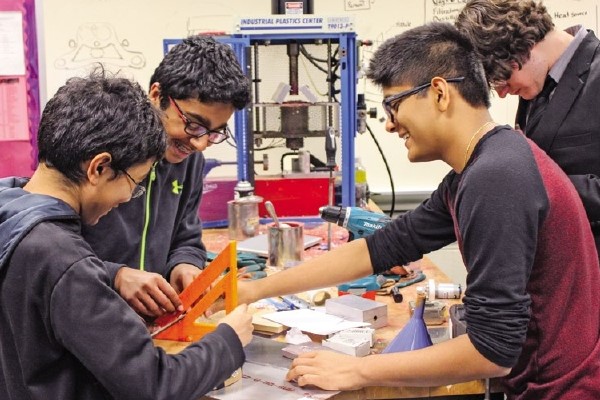Computational Thinking
May 01, 2017

The demands of preparing our students for the fast-paced changes unfolding in our global economy require a sense of urgency. Developing an education system that builds the capacities in our children to be innovative thought leaders, capable of solving
challenges of increasing complexity in our global system, lies at the heart of the transformation that has taken place at South Fayette Township School District over the last eight years.
The underlying questions for us are these:
- What are the capacities our students need to be innovative thought leaders?
- Must we completely rebuild our education system to address these capacities or can we make adjustments and change our traditional system to one that includes a mechanism designed to accelerate and sustain innovation?
Answering them is our focus for the 3,100 students in the South Fayette schools, located just southwest of Pittsburgh, Pa.
Identifying Capacities
Writing in the March 2006 issue of Communications of the ACM, Jeannette M. Wing, a corporate vice president at Microsoft Research, identified computational thinking as a fundamental skill that should be taught to all students. As she put it, “This mode of thinking involves solving problems, designing systems, and understanding human behavior by drawing on the concepts fundamental to computer science.”
In our school system, we have identified computational thinking as the new literacy and have embedded this process into STEAM learning — that’s science, technology, engineering and math plus the arts. Our definition, which is based on the appropriateness of K-12 education, includes three aspects.
The first aspect is the problem-solving process used in computer science, which is the ability to think logically, algorithmically, abstractly and recursively.
The second aspect addresses essential skills, such as habits of mind and the characteristics of intelligent and successful problem solvers. The latter encompass student confidence dealing with complexity, persistence and tolerance for ambiguity. This aspect also covers human-centered design thinking strategies and visible thinking routines. These ideas come from the works, most directly, of Art Costa and Bena Kallick (www.habitsofmindinstitute.org), the LUMA Institute (www.luma-institute.com) and Project Zero (www.pz.harvard.edu/projects/visible-thinking) at Harvard University.
The final aspect of our model covers career vision, which is an awareness of career contexts where the problem-solving processes, dispositions and attitudes apply. This helps students understand and envision how those careers reflect their learning.
Accelerating Innovation
Remaking education may seem like a monumental task, but we have learned that systemic and fundamental change can happen incrementally and be transformative without being drastic. Over the last eight years, we have systematically incorporated engineering and design problem solving, or computational thinking, into the district’s K-12 curriculum while developing a STEAM studio model for innovation.
Together, with the support of our board of directors and community, we have transformed traditional education by embedding computational thinking into the existing curriculum for students in all grade levels. Through the support of local foundations, we are addressing equity through outreach to schools in southwestern Pennsylvania. This began as a grassroots movement and has moved from practice to policy.
How did we meet this challenge and remake our educational model? After a few years of being immersed in an iterative process of embedding computational thinking into teaching and learning, we created a system that has become the mechanism for delivering and sustaining innovation.
Over a three-year period, the district hired STEAM teachers and facilitators for our elementary, intermediate and middle school buildings and changed existing positions and schedules to support STEAM learning and computational thinking. Positions such as a STEAM literacy teacher and technology education teachers have been reimagined and work in tandem with STEAM teachers to support innovation. In the high school, two teachers co-taught the newly designed Innovation Studio class.
The district’s STEAM Team K-12 meets formally several times a year to build and articulate vertical alignment and informally throughout the year. Because these positions support innovative instruction, what happens in these classes continues to evolve. This contributes to appropriate support of learning in computer science and other STEAM classes.
A Model’s Appearance

On any given day, you might step into a STEAM classroom and find students building keyboards and musical instruments out of cardboard, tape and copper wire and then using electrical circuitry and Scratch, block-based programming language (developed at the MIT Media Lab) to play music on cardboard keyboards. Or you might see students programming robotics using motors and sensors to make inventions that move or make sounds when they detect motion, while other students use Raspberry PI, a series of small single-board computers, to build and program their first computers — and that’s just what you would discover in 1st and 2nd grade.
At each grade level, computational thinking is aligned vertically and grows progressively deeper and more complex through a series of graduated and interrelated projects, creating deeper learning experiences moving from block-based to text-based code. Embedded into the curriculum and treated as another discipline, students are building mobile apps, programming Arduino boards (microcontroller boards), robotics, sensors and motors, and learning concepts of electrical circuitry. Over time, students are immersed in creative entrepreneurship as they move from ideation to 3-D product prototype learning to create products and services for social good.
The district created maker spaces or prototype labs in each building to address this transformational curriculum. In addition, we created a system for embedding innovation that involves using after-school incubator programs. Testing new ideas in incubators allows teachers to gauge students’ reaction and sense of engagement, provides flexibility in programming before embedding something new in the curriculum and creates teams of students and teachers who can act as teacher support during implementation.
Why It Works
An analysis of student achievement in the district reveals steady, positive gains over the last five years. Although South Fayette is one of the fastest-growing school districts in the state, averaging at least 100 new students per year, our academic scores continue to rise.
In 2013-14, the Pittsburgh Business Times listed South Fayette as the highest-achieving district in Allegheny County, Pa., on tests in mathematics and reading. In addition to retaining the top spot in 2014-15, South Fayette students a year later continued to rank first in average test scores in 3rd, 4th, 6th, 7th and 8th grades. The 5th-grade ranking was second among the 103 school districts in the newspaper’s comparison.
We realize the capabilities of innovative thinkers are not reflected on standardized tests. These skills are demonstrated through students’ abilities to design and create both within the curriculum and in after-school connected learning opportunities. Therefore, we know this model is working because our student teams are creating and beta testing their own unique design solutions.
For example, the BusBudE Team, a student-driven incubator under South Fayette’s emerging innovation leaders team, is beta testing an app it created that helps keep students safe while traveling to and from school on the bus. Young children scan their tag when entering the bus and an alert is sent to their parents, notifying them of the time and place their children enter and exit the school bus. Students presented their app to the MIT Media Lab and serve as guest bloggers for the Media Lab site. The same group of high school students recently won the Infosys Maker Award for their design. With the award’s $10,000 grant, our high school redesigned an area to create the maker space to foster the high school’s maker movement.
Another student team, the MyEduDecks Team, now a group of two seniors, a sophomore, two freshmen and two 8th graders, is in its fourth year of designing and beta testing a pen-based software flashcard application to be used for personalized learning and assessments. The students are conducting educational research by taking their product to maturity. Their work has been published in two books — The Impact of Pen and Touch Technology on Education and Revolutionizing Education with Digital Ink — with another publication due this spring. With district support, the students have presented their work at national conferences at Pepperdine University in Malibu, Calif., Microsoft Research in Seattle, and Brown University in Providence, R.I. Various other middle school and high school teams are designing unique products.
Each year, as seniors on the team graduate, younger students are added to build capacity, continue the research and develop products.
Our districtwide STEAM initiative is still in its infancy. We have much to discover as children continue to be problem designers, and we work to transform teaching and learning through innovation. We continuously pose questions and search for answers. Above all, we remain convinced that collectively we are capable of nurturing, supporting and sustaining innovation in education.
Bille Rondinelli is superintendent of the South Fayette Township School District in McDonald, Pa.
Aileen Owens is director of technology and innovation in the South Fayette district.
Additional Resources
Readers interested in learning more about South Fayette’s STEAM initiatives can consult these publications and videos.
- South Fayette’s STEAM model was discussed in “The Coding Revolution” by Annie Murphy Paul in Scientific American, August 2016.
- The district’s vertically aligned computational thinking model is described in a new book Emerging Research, Practice and Policy on Computational Thinking by Laurie Ruberg and Aileen Owens in the chapter titled “A Future-Focused Education — Designed to Create the Innovators of Tomorrow.”
- The district’s approach is addressed in Chapter 7 of the forthcoming book Critical Thinking at a Critical Time by William Gormley.
- South Fayette’s model for computational thinking is featured in a three-minute video produced by the district.
- “Students Who Teach, It’s All Part of Remaking the Education System” is a four-minute video created by public radio’s Fresh Air.
Advertisement
Advertisement
Advertisement
Advertisement



